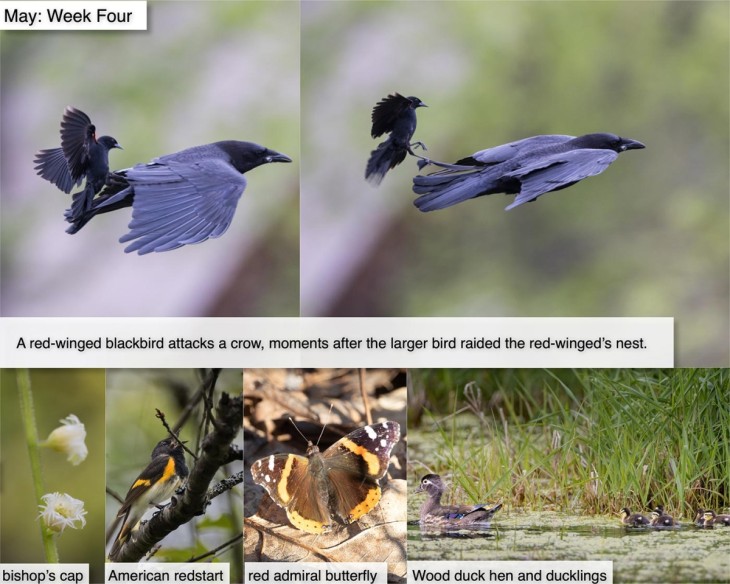This Week in the Woods, we’re continuing last week’s theme of high bird drama with two images (courtesy of Tig Tillinghast) of a male red-winged blackbird attacking a crow. Moments before, the crow had landed beside the smaller bird’s nest in a marsh and eaten something – probably a chick – that left the white patch on the side of the crow’s beak. Both red-winged parents attacked, and the male gave chase. As you can see, it bravely dug its claws into the crow’s back and pulled out feathers.
Common sights this week include goslings and ducklings following their mothers around the water. The photo shows a family of wood ducks, a species that (along with common and hooded mergansers) nests in tree holes, sometimes 60 feet or more above the forest floor. Within a few days after hatching, the ducklings leap out of the hole and follow their mother across the forest floor to the nearest water. You can read more about wood ducks in this Outside Story essay by Carolyn Lorié, which includes a description of “egg dumping” by sneaky hens that trick others into raising their young.
Now is a good time to see red admiral butterflies. These are common butterflies, no doubt in part because their caterpillars are able to feed on so many host plants in the nettles (Urticacaea) family. Like most butterflies that you find in the woods, they often get their nutrients from tree sap, in addition to nectaring on flowers.
Male American redstarts are back. Although species profiles describe them as interior forest birds, we often see them hunting insects in apple orchards and along forest edges. Male redstarts can be very territorial, and more in-your-face than most other warblers. One summer, we observed a redstart repeatedly dive-bombing a sleepy old dog who was trying to sunbathe on a lawn.
Finally, a reminder that some of the prettiest wildflowers are best appreciated with a hand lens, camera, or other form of magnification. The tiny flowers of bishop’s cap (also called two-leaf miterwort, or miterwort) have delicately fringed petals reminiscent of lace or snowflakes. If all goes well with pollination (syphid flies are common visitors), then the flowers will give way to dainty green cups, each containing a cluster of black seeds.
What have you noticed in the woods this week? Submit a recent photo for possible inclusion in our monthly online Reader Photo Gallery.


